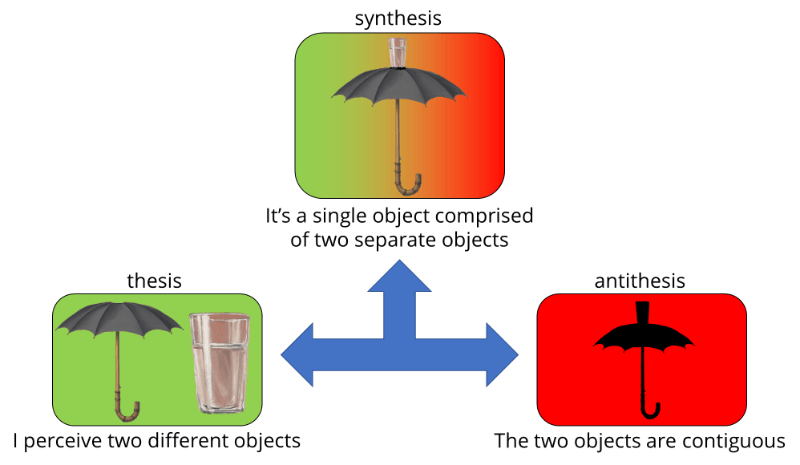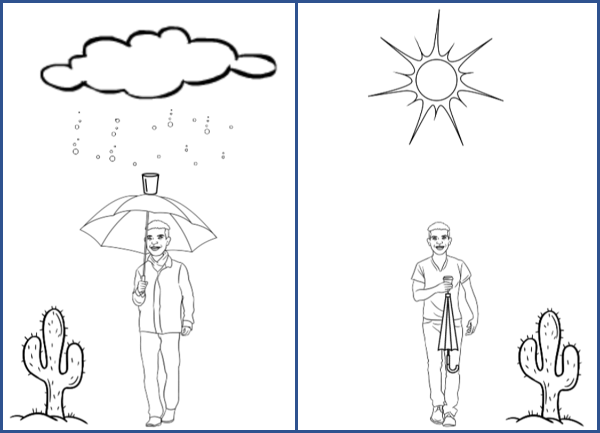This post is part of a larger deep dive
Curious about the role of Hegelian dialectic in Hegel’s Holiday? Check out Hegel’s Holiday Explained!
Or read the full Hegel’s Holiday article!
This post is part of a larger deep dive
Curious about the role of Hegelian dialectic in Hegel’s Holiday? Check out Hegel’s Holiday Explained!
Or read the full Hegel’s Holiday article!

If you read the previous section of Hegel’s philosophy, thinking that this analysis will be indeed very deep, I’m afraid I will have to disappoint you.
This is because Magritte did not employ the sort of rigorous logic demonstrations that any philosopher would readily go through.
To see why, here’s a letter written by Magritte to the art critic Suzi Gablik explaining the origin of the painting:
My latest painting began with the question: how to show a glass of water in a painting in such a way that it would not be indifferent? Or whimsical, or arbitrary, or weak – but, allow us to use the word, with genius? (Without false modesty.) I began by drawing many glasses of water, always with a linear mark on the glass. This line, after the 100th or 150th drawing, widened out and finally took the form of an umbrella. The umbrella was then put into the glass, and to conclude, underneath the glass. Which is the exact solution to the initial question: how to paint a glass of water with genius. I then thought that Hegel (another genius) would have been very sensitive to this object which has two opposing functions: at the same time not to admit any water (repelling it) and to admit it (containing it). He would have been delighted, I think, or amused (as on vacation), and I call the painting Hegel’s Holiday.
René Magritte
According to Hegel, every object is contradictory in itself. Every idea presupposes a tripartite division which involves the formation of a thesis, its antithesis and the resulting synthesis.
A simplistic reading of this painting could be that the two objects are a kind of negation of a negation (check out the section Negation of a negation). The umbrella is negating water (by repelling it), whereas the glass is negating the function of the umbrella (which is negating water).
So, you could think of the function of the glass as a negation of the negation, which is often interpreted as the synthesis in the context of the thesis-antithesis-synthesis triad.
But should we really think of the glass as a synthesis? Synthesis of what? What is the original idea that forms the thesis? Naively, we could think of the umbrella as a thesis. But if so, what is the contradiction, or antithesis? And even if an antithesis were formulated, why would a glass be the synthesis of the original idea, which is the umbrella?
Remember, the synthesis should incorporate the original idea, and elevate it to a higher stage of development.
These type of questions are the reason that the title reads Hegel’s Holiday and not Hegel’s at Work. Hegel would have find the painting of objects having contrasting functions amusing, but surely not worthy of a serious philosophical analysis.
That’s the reason why most analysis of this work refer to the two objects as contrasts, rather than contradictions. The umbrella that repels water is contrasted with the glass that admits water.
Fair enough. But let’s dissect this painting a little further.
You see, my initial mistake when I first looked at this painting was assuming that I was looking at two different objects: 1) a glass of water and 2) an umbrella.
But in Magritte’s letter to critic Suzi Gablik he writes: “I then thought that Hegel (another genius) would have been very sensitive to this object which has two opposing functions: at the same time not to admit any water (repelling it) and to admit it (containing it).”
I emphasised Magritte’s usage of the word “this object”, so that you notice that he is not referring to the umbrella and glass as two separate objects. He’s referring to the contents of the painting as an “object which has two opposing functions”.
So, the painting depicts an object which looks like a glass on top of an umbrella, an umbrella-glass object, if you like.
We established above that there is no contradiction really. The glass is not contradicting the function of the umbrella.
In fact, the composite object, which consists of an object (glass) which function is to admit water, and an object (the umbrella) which function is to repel water, is not contradictory. It’s actually complementary, and could, thus, be viewed as a synthesised object.
So, let’s go down a different route, and think how Hegel’s idea of contradiction can be applied to this synthesised object.

People look at Hegel’s Holiday and see two objects: a glass and an umbrella. You see two objects because they look dissimilar, and your daily experience with these objects tells you that they serve different purposes.
So that can be your thesis: “I perceive two different objects with contrasting functions”.
However, one could argue that maybe this is an artwork, maybe the two objects are supposed to be contiguous in space, meaning that they are really one single object – that would be the antithesis.
In fact, even though they are clearly two distinct objects, they are actually comprise one single entity (an umbrella-glass object), which provides two functions: repel and contain water. We have reached our synthesis (this is similar to Example 4 – Abstract ideas I mentioned above).
Note how this idea adheres to Hegel’s logic (check the section Spirit and the Hegelian dialectic):
1) we have an initial notion (they are two distinct objects) and its contradiction (they are one single object)
2) the contradiction is a logical negation of the initial notion
3) the synthesis (the umbrella-glass is both one and many) resolves the contradiction and elevates the original notion.
Now you say, “Ahhhh, why would we need such a thing as an umbrella-glass. That’s all made up!”
Yes, of course it’s made up. Still, the point I’m trying to convey is that any notion has a contradiction that is inherent to itself (in this case, that it is a single object, but also multiple objects), and this can be resolved by proper analysis of the initial notion.
One could even rationalise the reason one might need an umbrella-glass object (other than for the purpose of art).

Imagine a situation in which someone is lost in the desert. Let’s also pretend that that someone has a condition in which his skin is extremely sensitive to water. However, he is still human and needs to drink water to survive. He sights far away a rare agglomeration of clouds forming, and he in a conundrum: there is nowhere to take cover, but when it rains, he doesn’t want the water to pour down on him. However, this will probably be her last chance to collect water to survive.
Fortunately, he had forestalled her problem and brought along his unfailing umbrella-glass object: he takes cover under the umbrella, and the glass placed on top of the umbrella collects the water, which he drinks once the rain stops.
Of course, this is a silly example, but consider that if this idea was indeed useful, it would become part of our culture, part of world history. Perhaps even play a significant role in the development devices that, in the far future, could have a greater impact in the history of mankind.
Spirit manifests itself even in the smallest of ideas, because, ultimately, everything is connected through the dialectical process.
And this is what the Hegel’s dialectic is all about: elevating ideas above and beyond their original notions by use of contradictions and towards the ultimate goal of Absolute Knowledge.
Together with The Treachery of Images (the famous “this is not a pipe” painting), Hegel’s Holiday is one of the “entertaining” works by Magritte.
He imagined meeting with Hegel and showing him this painting, which Magritte believed would amuse the philosopher.
Hegel was famous for his dialectical method, which, simply put, deals with the constant contradiction of an idea, with the aim to reach truer knowledge.
But even though Magritte was an avid reader of Hegel, I don’t think he devoted an awful lot of time in logic analysis. In contrast to other Magritte paintings (e.g., Not to Be Reproduced), Hegel’s Holiday was meant to be humorous, rather than philosophical.
And so, keeping in line with the theme of the painting, I put forth a rather whimsical (if not silly) interpretation of Hegel’s Holiday in the context of the Hegellian dialectical method. Despite our experience telling us that the umbrella and glass are two separate objects with contrasting functions, they actually form a single entity (an umbrella-glass object), which could be thought of as a synthesised idea.
I think Hegel would have definitely enjoyed his holiday!
If, by any chance, I gave the impression of being dismissive of Hegel’s work, it couldn’t be further from the truth.
I actually think Hegel had a phenomenal insight with this idea of humans being inherently historical and that the progression of history is nothing more than the panning out of an extremely complex interaction of ideas (i.e., the dialectical process).
I have to admit though that in trying to understand Hegel I feel like it took a toll on my brain cells, so it might take a while to recover… 😀
See you in the next article!
Leave a comment
Add Your Recommendations
Popular Tags